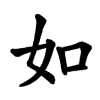Definify.com
Definition 2025
大
大
Translingual
| Stroke order | |||
|---|---|---|---|

| |||
Han character
大 (radical 37 大+0, 3 strokes, cangjie input 大 (K), four-corner 40030/40800, composition ⿻一人)
- Kangxi radical #37, ⼤ (“big”).
Derived characters
- Index:Chinese radical/大
Related characters
References
- KangXi: page 248, character 1
- Dai Kanwa Jiten: character 5831
- Dae Jaweon: page 492, character 25
- Hanyu Da Zidian: volume 1, page 520, character 1
- Unihan data for U+5927
Chinese
|
simp. and trad. |
大 | |
|---|---|---|
Glyph origin
| Historical forms of the character 大
| ||||
|---|---|---|---|---|
| Oracle bone script | Bronze inscriptions | Bamboo and silk script | Large seal script | Small seal script |
 |
 |
 |
 |
 |
| Characters in the same phonetic series (大) (Zhengzhang, 2003) | |
|---|---|
| Old Chinese | |
| 馱 | *daːl, *daːds |
| 大 | *daːds, *daːds |
| 忕 | *tʰaːds, *daːds, *djads |
| 太 | *tʰaːds |
| 汰 | *tʰaːds |
| 汏 | *daːds, *tʰaːd |
| 軑 | *daːds, *deːds |
| 釱 | *daːds, *deːds |
| 达 | *tʰeːds |
| 杕 | *deːds |
Ideogram (指事) : a person 人 with arms stretched out as far as possible, implying the meaning of big/great/large. This is in contrast to 小 which represents a person 人 with lowered arms implying small in size.
Compare with 尢, which is a man with bent legs with the meaning of weak.
Compare also 文, which is a man with arms outstretched and a crest or tattoo on his chest denoting culture or language, and to 夭, which is a man with arms outstretched and leaning to side (running), denoting youth.
Etymology
Three pronunciations can be found in Modern Standard Chinese:
- Modern dà, from Middle Chinese dɑL, from Old Chinese *lˤaːts. The phonological development from Old Chinese to Middle Chinese is irregular. Original sense: "big" (Shijing). Derived senses: "size" (Mozi), "thick" (Zhuangzi), "to respect" (Mengzi), "to respect" (Xunzi), "to extol" (Gongyang Zhuan), "to exaggerate" (Classic of Rites), "arrogant" (Guoyu), "good" (I Ching), "(of time) long" (Erya), "senior" (Shijing).
- Modern dài, from Middle Chinese dɑiL, from Old Chinese *lˤaːts. This Middle Chinese pronunciation-preserving (i.e. literary) pronunciation occurs only in compounds such as 大夫 (dàifu, “doctor”) and 大王 (dàiwang, “(in operas, old novels) king; ringleader”).
- Modern tài, from Middle Chinese tʰɑiL, from Old Chinese *l̥ˤaːts. This is the ancient form of 太 (tài, “too, excessively”) and is obsolete in modern languages.
Pronunciation 2), the diphthong reading, is traditionally regarded as the correct one. However, the monophthong reading 1) has been recorded as early as Han Dynasty, and Sui-Tang rhyme books record both. Both readings are reflected in Sino-xenic readings in non-Sinitic languages, although the diphthong readings dominate in compounds. Axel Schüssler postulates that all pronunciations can eventually be traced back to liquid initials, i.e. 1,2) **laːts, 3) **hlaːts.
The three pronunciations are cognate. Within Chinese, they are cognate with 太 (OC *tʰaːds, “too, excessively”), 泰 (OC *tʰaːds, “big”), 誕 (OC *l'aːnʔ, “big, magniloquent, ridiculous”). There are no unambiguous Tibeto-Burman cognates. Proto-Tibeto-Burman *taj (“big”), from which came Written Tibetan མཐེ་བོ (mthe bo, “thumb”), Nung tʰɛ ("big, large, great"), Mikir tʰè, ketʰè ("id."), Burmese တယ် (tai, “very”), is often compared with. There is no final –s in the Tibeto-Burman words, but a –y, which, according to James Matisoff, "indicates emergent quality in stative verbs". Also compare Chinese 多 (OC *ʔl'aːl, “many, much”), 都 (OC *taː, “all”).
Pronunciation 1
- Mandarin
- Cantonese (Jyutping): daai6
- Hakka (Sixian, PFS): thai
- Min Dong (BUC): duâi
- Min Nan
- Wu (Wiktionary): du (T3); da (T3)
- Mandarin
- (Standard Chinese, Beijing)+
- Pinyin:
- Zhuyin: ㄉㄚˋ
- Wade-Giles: ta4
- Gwoyeu Romatzyh: dah
- IPA (key): /ta̠⁵¹/
-

- (Standard Chinese, Beijing)+
- Cantonese
- (Standard Cantonese, Guangzhou)+
- Jyutping: daai6
- Yale: daaih
- Cantonese Pinyin: daai6
- IPA (key): /tɑːi̯²²/
- (Standard Cantonese, Guangzhou)+
- Hakka
- (Sixian, incl. Miaoli and Meinong)
- Pha̍k-fa-sṳ: thai
- Hakka Romanization System: tai
- Hagfa Pinyim: tai4
- IPA: /tʰa̯i⁵⁵/
- (Sixian, incl. Miaoli and Meinong)
- Min Dong
- (Fuzhou)
- Bàng-uâ-cê: duâi
- IPA (key): /tuɑi²⁴²/
- (Fuzhou)
- Min Nan
- (Hokkien)
- Pe̍h-ōe-jī: tōa / tāi
- Tâi-lô: tuā / tāi
- Phofsit Daibuun: doa, dai
- IPA (Xiamen): /tua²²/, /taɪ²²/
- IPA (Quanzhou): /tua⁴¹/, /taɪ⁴¹/
- IPA (Zhangzhou): /tua²²/, /taɪ²²/
- IPA (Taipei): /tua³³/, /taɪ³³/
- IPA (Kaohsiung): /tua³³/, /taɪ³³/
- Note: tōa - vernacular; tāi - literary.
- (Teochew)
- Peng'im: dua7 / dai6
- Pe̍h-ōe-jī-like: tuā / tăi
- IPA (key): /tua¹¹/, /tai³⁵/
- Note: dua7 - vernacular; dai6 - literary.
- (Hokkien)
- Wu
- (Shanghainese)
- Wiktionary: du (T3); da (T3)
- IPA (key): /d̻v̩ʷ²³/, /d̻ᴀ²³/
- Note: 3du - vernacular; 3da - literary.
- (Shanghainese)
- Dialectal data▼
| Variety | Location | 大 (大小) |
|---|---|---|
| Mandarin | Beijing | /ta⁵¹/ |
| Harbin | /ta⁵³/ | |
| Tianjin | /tɑ⁵³/ | |
| Jinan | /ta²¹/ | |
| Qingdao | /ta²¹³/ | |
| Zhengzhou | /ta³¹²/ | |
| Xi'an | /ta⁴⁴/ | |
| Xining | /ta²¹³/ | |
| Yinchuan | /ta¹³/ | |
| Lanzhou | /ta¹³/ | |
| Ürümqi | /ta²¹³/ | |
| Wuhan | /ta³⁵/ | |
| Chengdu | /ta¹³/ | |
| Guiyang | /ta²¹³/ | |
| Kunming | /ta̠²¹²/ | |
| Nanjing | /tɑ⁴⁴/ | |
| Hefei | /ta⁵³/ | |
| Jin | Taiyuan | /ta⁴⁵/ |
| Pingyao |
/tei³⁵/ /tɑ³⁵/ |
|
| Hohhot | /ta⁵⁵/ | |
| Wu | Shanghai |
/da²³/ /du²³/ |
| Suzhou | /dəu³¹/ | |
| Hangzhou |
/dɑ¹³/ /do¹³/ |
|
| Wenzhou |
/da²²/ /dɤu²²/ |
|
| Hui | Shexian |
/tʰa²²/ /tʰo²²/ |
| Tunxi | /tʰo¹¹/ | |
| Xiang | Changsha |
/ta⁵⁵/ /tai¹¹/ |
| Xiangtan | /dai²¹/ | |
| Gan | Nanchang | /tʰo²¹/ ~娘,姑母 |
| Hakka | Meixian | /tʰai⁵³/ |
| Taoyuan | /tʰɑi⁵⁵/ | |
| Cantonese | Guangzhou | /tai²²/ |
| Nanning | /tai²²/ | |
| Hong Kong | /tai²²/ | |
| Min | Xiamen (Min Nan) |
/to²²/ /tua²²/ |
| Fuzhou (Min Dong) | /tuɑi²⁴²/ | |
| Jian'ou (Min Bei) | /tuɛ⁴⁴/ | |
| Shantou (Min Nan) |
/tai³⁵/ /tua³¹/ |
|
| Haikou (Min Nan) |
/ʔda³⁵/ /ʔdua²³/ |
| Rime | ||
|---|---|---|
| Character | 大 | 大 |
| Reading # | 1/2 | 2/2 |
| Initial (聲) | 定 (7) | 定 (7) |
| Final (韻) | 泰 (25) | 歌 (94) |
| Tone (調) | Departing (H) | Departing (H) |
| Openness (開合) | Open | Open |
| Division (等) | I | I |
| Fanqie | 徒蓋切 | 唐佐切 |
| Reconstructions | ||
| Zhengzhang Shangfang |
/dɑiH/ | /dɑH/ |
| Pan Wuyun |
/dɑiH/ | /dɑH/ |
| Shao Rongfen |
/dɑiH/ | /dɑH/ |
| Edwin Pulleyblank |
/dajH/ | /daH/ |
| Li Rong |
/dɑiH/ | /dɑH/ |
| Wang Li |
/dɑiH/ | /dɑH/ |
| Bernard Karlgren |
/dʱɑiH/ | /dʱɑH/ |
| Expected Mandarin Reflex |
dài | duò |
| Baxter-Sagart system 1.1 (2014) | ||
|---|---|---|
| Character | 大 | 大 |
| Reading # | 1/2 | 2/2 |
| Modern Beijing (Pinyin) |
dà | dà |
| Middle Chinese |
‹ daH › | ‹ dajH › |
| Old Chinese |
/*lˤat-s/ (MC F!) | /*lˤa[t]-s/ |
| English | big | big |
Notes for Old Chinese notations in the Baxter-Sagart system: * Parentheses "()" indicate uncertain presence; | ||
| Zhengzhang system (2003) | ||
|---|---|---|
| Character | 大 | 大 |
| Reading # | 1/2 | 2/2 |
| No. | 1934 | 1939 |
| Phonetic component |
大 | 大 |
| Rime group |
祭 | 祭 |
| Rime subdivision |
1 | 1 |
| Corresponding MC rime |
䭾 | 大 |
| Old Chinese |
/*daːds/ | /*daːds/ |
Definitions
大
- big; large; huge
- Antonyms: 小 (xiǎo)
- big; great; deep
- main; major
- loud; heavy
- mature; grown up
- ⇒ 老
- greatly; very much
- (dialectal) father
- (dialectal) father's elder or younger brother
- Short for 大學/大学 (dàxué, “university”). Used only in the abbreviation of the name.
- 北大 ― Běi Dà ― Peking University
Pronunciation 2
- Mandarin
- (Standard Chinese, Beijing)+
- Pinyin:
- Zhuyin: ㄉㄞˋ
- Wade-Giles: tai4
- Gwoyeu Romatzyh: day
- IPA (key): /taɪ̯⁵¹/
- (Standard Chinese, Beijing)+
- Pinyin:
- Zhuyin: ㄉㄚˋ
- Wade-Giles: ta4
- Gwoyeu Romatzyh: dah
- IPA (key): /ta̠⁵¹/
- Note: dà - variant used in ringleader; monarch.
- (Standard Chinese, Beijing)+
- Cantonese
- (Standard Cantonese, Guangzhou)+
- Jyutping: daai6
- Yale: daaih
- Cantonese Pinyin: daai6
- IPA (key): /tɑːi̯²²/
- (Standard Cantonese, Guangzhou)+
- Hakka
- (Sixian, incl. Miaoli and Meinong)
- Pha̍k-fa-sṳ: thai
- Hakka Romanization System: tai
- Hagfa Pinyim: tai4
- IPA: /tʰa̯i⁵⁵/
- (Sixian, incl. Miaoli and Meinong)
- Min Dong
- (Fuzhou)
- Bàng-uâ-cê: dâi
- IPA (key): /tɑi²⁴²/
- (Fuzhou)
- Min Nan
- (Hokkien)
- Pe̍h-ōe-jī: tāi
- Tâi-lô: tāi
- Phofsit Daibuun: dai
- IPA (Xiamen): /taɪ²²/
- IPA (Quanzhou): /taɪ⁴¹/
- IPA (Zhangzhou): /taɪ²²/
- IPA (Taipei): /taɪ³³/
- IPA (Kaohsiung): /taɪ³³/
- (Teochew)
- Peng'im: dai6
- Pe̍h-ōe-jī-like: tăi
- IPA (key): /tai³⁵/
- (Hokkien)
Definitions
大
- Only used in 大夫 (dàifu, “doctor”).
- Only used in 大城 (“Daicheng, Hebei”).
- Only used in 大王 (dàwáng, “(in operas, old novels) king; ringleader”).
Pronunciation 3
| For pronunciation and definitions of 大 – see 太. (This character, 大, is an ancient form of 太.) |
Compounds
|
|
|
Descendants
Japanese
Kanji
Readings
- Goon: だい (dai), だ (da)
- Kan’on: たい (tai), た (ta)
- Kun: おお (ō), おおきい (大きい, ōkii), おおいに (大いに, ōini)
- Nanori: うふ (ufu), お (o), た (ta), たかし (takashi), とも (tomo), はじめ (hajime), ひろ (hiro), ひろし (hiroshi), ふとし (futoshi), まさ (masa), まさる (masaru), もと (moto), ゆたか (yutaka), わ (wa)
Compounds
|
|
Etymology 1
| Kanji in this term |
|---|
| 大 |
|
だい Grade: 1 |
| on'yomi |
Pronunciation
Prefix
大 (hiragana だい, romaji dai-)
- big, large
- the large part of
- university
Usage notes
This is often the first half two-character shorthand name of universities, for example 東大 (Tokyo University, “Tōdai”)
Etymology 2
Prefix
大 (hiragana おお, romaji ō-, historical hiragana おほ)
References
- ↑ 2006, 大辞林 (Daijirin), Third Edition (in Japanese), Tōkyō: Sanseidō, ISBN 4-385-13905-9
- ↑ 1998, NHK日本語発音アクセント辞典 (NHK Japanese Pronunciation Accent Dictionary) (in Japanese), Tōkyō: NHK, ISBN 978-4-14-011112-3
Korean
Hanja
大 • (dae, tae)
Eumhun:
- Name (hangeul): 크다 (revised: keuda, McCune-Reischauer: k'ŭda, Yale: khuta)
- This term needs a translation to English. Please help out and add a translation, then remove the text
{{rfdef}}.
Compounds
- 방대 (厖大, bangdae)
- 대음순 (大陰脣, daeeumsun, “labia majora”)
- 적소성대 (積小成大, jeoksoseongdae)
- 전권대사 (全權大使, jeon-gwondaesa)